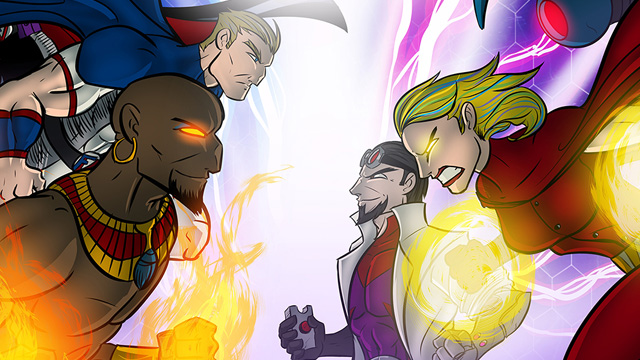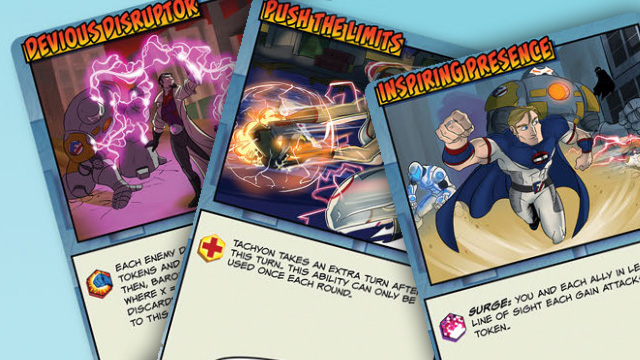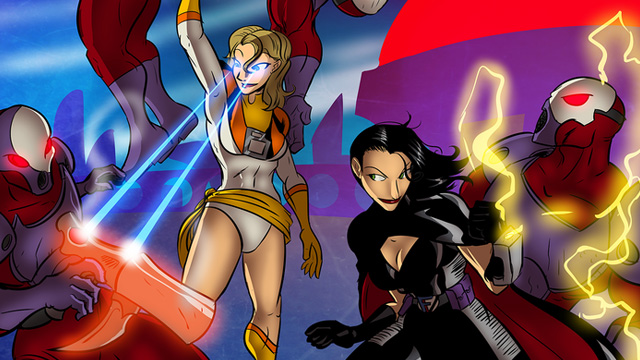
Sentinels of the Multiverse remains one of my favorite games of all-time, but I readily admit that the mechanics can be a bit much at times. Fortunately, my friends and I have decades of playing and judging Magic: the Gathering under our collective belts to help us manage dozens of card effects. If you’ve tried Sentinels and enjoyed the concept but found it too “mathy,” perhaps a more tangible system is for you: enter Sentinel Tactics.
Like the card game, Sentinel Tactics follows the exploits of an original group of characters created by the team at Greater Than Games. In the base set, The Flame of Freedom, only six heroes are included: the Freedom Five (Legacy, The Wraith, Bunker, Tachyon, and Absolute Zero) and the flame-slinging Ra. They are joined — or rather opposed — by Baron Blade, Citizen Dawn (and her Citizens of the Sun) and the fifth iteration of Omnitron. Its first expansion, Uprising, adds Visionary, Unity and Beacon (formerly “Young Legacy”), as well as Ambuscade, Proletariat and The Operative (plus her new underbosses and thugs). The base set also features map tiles depicting classic Sentinels environments Megalopolis and Insula Primalis.
Other than the focus on map-based tactical combat, the most obvious difference between Tactics and the card game is the fact that the game is no longer cooperative. At least one player in each game will take active control of the villain(s) in the scenario. Most scenarios support one or two villain players and from two to four hero players, although it is not too difficult for one player to manage two heroes for a one-on-one game. You can also play skirmishes using whatever rules you wish, even hero-vs.-hero or villain-vs.-villain if that’s your thing.

The scenarios I mentioned are literally presented in comic-book format, which is awesome. After a couple of pages of comic exposition, there is a page detailing the board setup, rules of engagement, special conditions and objectives of each side. Each comic has four scenarios, and there are even “continuing the story” details that modify later scenarios based on the results of previous ones if you want to play though the entire comic. I love the attention to detail that the GTG guys put into their work, and the fact that they are having the time of their lives creating this is readily apparent.
So with that out of the way, how does the game actually play? Fairly simply, as it turns out. Each character has a base card that details various basic parameters, as well as a handful of cards that represent additional powers, abilities or companions (like Unity’s bots). At the beginning of each character’s turn (“Power-Up phase”), they may return one of these cards to their hand and then may play any one they wish as long as they are not at their maximum capacity, usually two. This allows for a wide range of strategic choices. After the Power-Up phase, any “surge” effects on cards in play happen as indicated.
The meat of each turn happens in the following “Go Time!” phase. Each character has a specific number of actions to take each turn, typically two or three. It is important to note that unless a move is labeled as being “unlimited,” no action can be taken more than once per turn. In addition to whatever actions are made available by cards, every character has access to the same four basic actions: movement, sprinting, dodging and aiming. Moving allows a character to move a number of hexes equal to their current move value, spending additional points for every level of elevation they traverse along the way unless the hero has “mobility,” often represented by flight powers or similar effects. Sprinting allows only two hexes of movement but ignores elevation, making it handy for difficult terrain.

Attacks are handled by dice, as might be expected. Each attack action has a display indicating how many dice are rolled as well as things like type, range and area of effect. It also has a chart telling you which numbers count as automatic misses when rolled. To make an attack, you first decide if you want to spend an Aim token, then roll the appropriate number of dice; if you have an Attack -1 token, you must spend one and as a result roll one fewer die. After rolling, you may spend any Attack +1 tokens you might have to roll one additional die per token you spend. Then any dice that show auto-miss numbers are discarded. If you spent an Aim token, any remaining dice are all treated as if they rolled your highest value. Finally, check for range. Every hex between you and your target counts as one, plus one for each elevation level difference. Any dice that rolled under that range value miss, and everything else hits.
Defending works in a similar manner, only substituting Dodge and Defense tokens as appropriate. Obviously defense doesn’t have to check range and can’t “miss,” but instead you are checking against the dice that hit you. You can block each “hit” with a die of equal or higher value. Any hits that break through remove one of your health. If you run out of health, your character is incapacitated and effectively loses the next turn to get up out of the rubble. Being incapacitated also resets any One-Shot powers you might have spent, which is handy.
The final phase of a turn is “To be continued…”. Mostly what happens here is setting your move value for your next turn. Different characters have different ways of determining this, but they all involve rolling a specific number of dice and then taking either the highest, lowest or median value depending on your character’s relative speed. Finally, indicate that your turn is over by flipping over your assigned turn order marker.

On the whole, this is a rather elegant tactical system that doesn’t get bogged down by a lot of details. There are line-of-sight rules that basically boil down to “no hexes of different elevation between the two end points”, some cover rules that are equally simple (and currently only relevant on parts of the Insula Primalis maps) and hazard spaces that trigger passive attacks against anyone who enters their range, but on the whole nothing incredibly difficult. Most of the complexity comes from elevation, represented by dots on each hex, and the effect that it has on range and movement.
But, as always, dice will be dice. If you don’t roll well on important actions or if your opponents repeatedly blast you with a bunch of range-defying long shots, you probably aren’t going to have a lot of fun with Sentinel Tactics. Most tactical gamers should be used to that by now and will really enjoy Tactics, but personally I think I’ll stick to the cards.
Speaking of things tactical gamers are used to: miniatures. The base games use cardboard tokens to represent each character, which get the job done just fine. That said, additional minis packs (both painted and unpainted) are available for those who want to push figures around and make the game look a little nicer.
Sentinel Tactics large sets (like Flame of Freedom) retail for $40, and small sets (Uprising) go for $20. Unpainted minis packs retail for $30, and painted ones for $90.



















